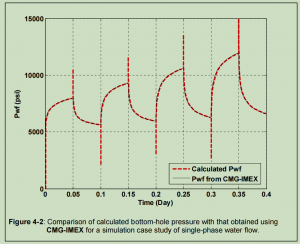Validation of a New and Cost Effective Technique to Estimate Reservoir Pressure and Permeability in Low-Permeability Reservoirs
Abstract
I developed the mathematical basis for a new and cost effective method to estimate reservoir pressure and effective water permeability in low permeability reservoirs. This method, called Baseline/Calibration, was successfully tested in Wamsutter fields. This approach, which is an alternative to time-consuming DFIT tests and conventional pressure buildup tests, requires injection of water in multiple short stages. Sandface pressure and flow rate are analyzed to estimate reservoir pressure and permeability.
I derived analytical expressions which provide a mathematical basis for this method. The analytical formulations are based on transient solutions to the diffusivity equation, the principle of superposition, and assume piston-like displacement of reservoir fluids with injected water.
I constructed several numerical simulation models and validated the proposed technique. I also analyzed flow rate and pressure data from two field trials performed in the Almond formation of the Wamsutter field. The results of numerical simulation and field trials of this method verified that our method accurately determines reservoir pressure with short injection tests.
Reservoir pressure is a fundamental property of the reservoir and its depletion provides an insight in to the reservoir dynamics and drainage pattern. Measurements of formation pressure and in-situ reservoir permeability are important for a variety of reasons including estimation of ultimate recovery, production forecasting, and optimization of depletion planning.
Unconventional gas reservoirs are economically viable hydrocarbon prospects that have proven to be very successful. However, conventional well tests methods are often impractical in unconventional reservoirs. Long shut-in times are required for estimates of reservoir pressure and reservoir permeability.
Simulator: CMG-IMEX



